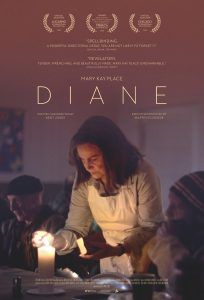
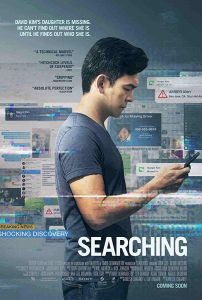
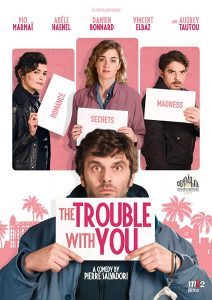





“Searching” (2018). Cast: John Cho, Debra Messing, Sara Sohn, Michelle La, Joseph Lee, Alex Jayne Go, Megan Liu, Kya Dawn Lau, Ric Sarabia. Director: Aneesh Chaganty, Screenplay: Aneesh Chaganty and Sev Ohanian. Web site. Trailer.
We can take comfort in knowing that certain aspects of our life are exactly as they seem to be. Or can we? Are we getting a clear, accurate picture of the people, places and things that make up our existence? Or are we falling prey to what we’d like to think we know about such elements of our reality? The result can be eye-opening – and disillusioning – as an anguished parent discovers for himself in the sizzling thriller, “Searching,” now available on DVD, Blu-ray disc and video on demand.
When David Kim (John Cho) loses his wife, Pam (Sara Sohn), to lymphoma, he’s devastated by her death. However, with his teenage daughter Margot (Michelle La) to raise, he needs to pull things together to help the adolescent become the talented and successful young woman who has made him and her late mother so proud. He provides a deft mixture of love, support and gentle but firm guidance in hopes that he’ll be able to complete a task on his own that he had so lovingly shared with his deceased beloved.
One evening while Margot is at a study group meeting at a friend’s home, she contacts her dad via video phone to let him know that she’ll be staying late with her classmates. He takes note of her call and, not long thereafter, goes to bed. While David’s asleep, though, Margot apparently phones again, leaving a message to have him call her back. Upon awakening, David gets the message and returns the call only to get Margot’s voicemail – a process that’s repeated several more times with no response. Needless to say, he’s worried.
David methodically tries to track down his daughter’s whereabouts throughout the metropolitan San Jose area. He contacts friends, parents of friends, her piano teacher and others, all to no avail. He learns she didn’t show up for school, a cause for greater concern. He then goes through her computer records, tapping into her email and various web sites to see if he can obtain additional clues about new places to look. But, when those leads continually come up empty, he realizes he needs to contact authorities. He reaches out to the police, who assign Detective Rosemary Vick (Debra Messing) to his case.
Detective Vick takes a strong interest in the investigation, urging David to find out as much as he can about his daughter’s online life in hopes that any new revelations will provide help in solving her disappearance. He agrees and begins probing Margot’s cyber identity in earnest. And what he finds shocks him: Margot, it seems, is nothing at all like he’s thought she is – secretive, a relative loner and someone who has contacts with people he never dreamed she’d associate with.
The discovery overwhelms David, but, as requested by the police, he shares what he finds. Ever the professional, Detective Vick offers whatever official advice she can, but, as a parent herself, she also seeks to provide solace by telling David about her own personal experience with her troubled teenage son, a story not unlike what appears to be unfolding with Margot. David takes some comfort in this, but it doesn’t change the fact that his daughter is still missing.
Together, David and Detective Vick continue to work the process of trying to find the missing teen, an undertaking that grows ever more disturbing and confounding, especially when many seemingly possible leads don’t pan out or turn out to be utterly frustrating red herrings. It’s stressful, too, particularly when some of the revelations involve individuals David never would have suspected as being part of this, such as his brother, Peter (Joseph Lee). Many illusions, it seems, come up for shattering.
To say more would reveal too much about how this picture plays out. However, as the story progresses, David is faced not only with the challenge of finding Margot, but also with having to reconstruct the cherished and seemingly unshakable impressions he holds about her and others. It’s a lot to go through all at once, especially since it’s coming not long after his wife’s passing. And it’s a story that proves trying both for the protagonist, as well as those watching it.
“Searching” is a story that has much to do with what we believe about others. But, as becomes apparent, we find that those beliefs can prove inaccurate, largely because they’re rooted in what we would like to believe about them. Unfortunately, when we imbue others with traits that we hold dear and those qualities don’t jibe with those that they believe about themselves, we can come up against the devastatingly disillusioning outcome that our colleagues, family and friends may not live up to our expectations.
Understanding this is crucial if we hope to establish realistic and meaningful impressions of others. It means using the power of discernment to get an accurate handle on our beliefs about them and to avoid the pitfall of distorted wishful thinking. But, then, this goes without saying for any undertaking we attempt to pursue through the conscious creation process, the philosophy that maintains we draw upon such metaphysical resources in manifesting the reality we experience.
Of course, we must also understand that, when it comes to our interpersonal relationships, these are co-creations that involve both us and others. Their beliefs figure into the equation as much as ours do, and, while we may not be able to get a precise handle on the beliefs of others, we might be able to glean insights about them by tapping into our intuition, one of the key components that factor into our belief formation. Regrettably, this is a resource we tend to underutilize, mainly because its nature tends to be viewed with skepticism, seemingly less trustworthy than our rational, logical intellect. By shortchanging it, however, we cut ourselves off from something that could prove valuable in grasping the motivations and outlooks of those we seek to understand.
This is particularly crucial in the age of the Internet, where it’s possible – in fact, quite easy – to distort our persona, creating one that deviates significantly from the face we show the world in person. It’s even feasible to fabricate an entirely different profile of ourselves, one that’s intentionally cryptic or deceiving, making it difficult for others to discover who’s really behind the mask. That’s a point driven home here by setting the entire film in cyberspace, with the story told on computer screens using video cameras, web site pages, pop-up windows, and text and email messages, showing how easy it is to convey deliberately crafted, purposely camouflaged impressions of oneself. One might legitimately wonder why anyone would do such a thing, but, given that conscious creation makes any outcome possible, there may well be reasons behind such an endeavor that others may understand but that we don’t.
Such undertakings can prove particularly difficult to unwind in scenarios like the one David faces in this film. When one approaches these circumstances from a standpoint of heartfelt love and sincere intent but repeatedly comes up against calculated subterfuge and deliberate deception, the result can be devastating, both from a disillusionment standpoint, as well as where our emotions are concerned. It’s a situation no one would wish on another, especially a loving, desperate parent seeking to find a lost child.
This slow-burning, intense thriller has more twists and turns than a winding mountain road. What’s more, through this novel feature film debut, director Aneesh Chaganty, a former Google employee, has created a new storytelling approach that uses an innovative cinematic vocabulary, opening the door to an inventive way of spinning yarns on celluloid. Admittedly, some of the computer screen contents pass by a little too quickly and could stand to be enlarged in some instances, but this is a minor shortcoming in the overall narrative context. Moreover, in telling the story in this way, Chaganty offers viewers a potent cautionary tale about the pitfalls of cyberspace communications and what we can actually believe about the material showing up on our computer screens, particularly when it comes to the identity of the individuals we’re supposedly communicating with.
This largely overlooked cinematic gem came and went from theaters rather quickly when it was released in late 2018, but, thankfully, it seems to be finding a life of its own on home viewing options. It has also been the recipient of a number of accolades, such as its selection as one of the National Board of Review’s Top 10 Independent Films of 2018. It earned John Cho an Independent Spirit Award nomination for best male lead. And, at last year’s Sundance Film Festival, the picture picked up the Audience Award and the Alfred P. Sloan Feature Film Prize. Not bad for a first feature from a new industry voice.
In the end, as this film shows, we’re all searchers at heart, an effort made easier by the rise of the Internet and a growing understanding of our inner selves, phenomena that in many ways are mirrors of one another. As we try to grasp who we are, the nature of existence and our place in it, we embark on journeys of discovery of all kinds, hoping that they’ll give us meaningful insight into our conscious awareness and the human experience. But, as we set out on such odysseys, we must be prepared for a variety of situations, and the more we can do so by developing our proficiency as conscious creators, the better off we’ll be – or so one would hope.
Copyright © 2019, by Brent Marchant. All rights reserved.
“The Trouble with You” (“En liberté!”) (2018). Cast: Adèle Haenel, Pio Marmaï, Audrey Tautou, Vincent Elbaz, Damien Bonnard, Hocine Choutri, Octave Bossuet. Director: Pierre Salvadori. Screenplay: Benjamin Charbit, Benoît Graffin and Pierre Salvadori. Web site. Trailer.
How far are we willing to go to make amends? To be sure, many of us justifiably feel compelled to right our wrongs, often with good reason. But, when it comes to compensating for the misdeeds of others for whom we feel responsible, how long must we leave ourselves on the hook, if at all? That’s a conundrum faced by a noble public servant with good intentions – and not always the best results – in the wacky new French farce, “The Trouble with You” (“En liberté!”).
To the residents of a French Riviera resort town, Police Captain Jean Santi (Vincent Elbaz) is a local hero. Having successfully taken on local crime figures, such as drug kingpin Mariton (Hocine Choutri), Santi is hailed for his daring heroics, an accomplishment that even earns him a statue on the town’s waterfront. It’s seen as a fitting tribute to a detective who lost his life in the line of duty, leaving behind his police lieutenant wife, Yvonne (Adèle Haenel), and his idolizing young son, Théo (Octave Bossuet). There’s just one problem with all the accolades: they’re undeserved.
Two years after Santi’s death, Yvonne learns that her husband was a crooked cop. While conducting a raid on a shady S&M parlor, Yvonne discovers that Jean took a hefty cut from an insurance claim related to a scam involving a jewelry store robbery, one that also netted a sizable rock for his wife’s hand. What’s worse, though, she also finds out that Jean covered his tracks by framing an innocent man, Antoine Parent (Pio Marmaï), who has spent the past eight years in prison.
Outraged, Yvonne plans to blow the whistle on her late husband to a local judge. But family friend and fellow cop Louis (Damien Bonnard) dissuades her from doing so, suggesting that such a revelation would tarnish Théo’s memory of his father. Besides, with Antoine’s release from jail only two weeks away, Louis contends that any intervention on Yvonne’s part at this point wouldn’t substantially reduce his sentence.
In light of the foregoing, Yvonne decides to shelve her plan. However, she nevertheless feels compelled to make amends for her husband’s actions. Given the injustice perpetrated against Antoine, she wants to help smooth his transition from prison to everyday life. She’s especially concerned about his well-being when she learns that incarceration has been difficult for him. In response to being erroneously locked up, Antoine has developed anger management issues and violent tendencies, traits that threaten to flare up inexplicably on a moment’s notice. And now that he’s about to be let back into society, Yvonne is worried that he might harm himself or others, perhaps causing significant harm and winding up back behind bars in no time, all through no fault of his own.
Upon Antoine’s release, he’s agitated at what happened to him and quietly hatches plans to seek revenge against a society that he believes treated him unfairly. But, given that he’s easily confused by everything that has happened, he doesn’t always think things through, exhibiting behavior that often comes across as erratic. His devoted wife, Agnès (Audrey Tautou), who has waited faithfully for his return, does her best to cope with him, but it’s more than she can handle. Something needs to be done to keep Antoine out of harm’s way.
Enter Yvonne. As she learns of Antoine’s cockeyed schemes, she clandestinely seeks to intervene, trying to rectify matters anonymously before he gets in trouble. However, when he soon discovers her, he immediately becomes smitten, and suddenly she has a second set of issues to contend with. Yvonne clearly wants to do the right thing, but how far will she need to go to keep everything stable?
To complicate matters, Yvonne also must wrestle with a number of other issues, such as the ongoing fallout from the raid that she and her peers conducted at the S&M parlor. Then there’s the growing affection being shown her by co-worker Louis, who begins making his moves at the same time as Antoine’s advances. And, through it all, she also has her responsibilities as a single parent, doing what she can to raise her son and shield him from the truth about (and her growing anger at) his late father. It’s a full plate, to say the least.
[caption id="attachment_10673" align="aligncenter" width="300"] Police lieutenant Yvonne Santi (Adèle Haenel, right) seeks to help wrongly incarcerated ex-con Antoine Parent (Pio Marmaï, left) after his release from jail in the delightful French farce, “The Trouble with You” (“En liberté!”).[/caption]
Police lieutenant Yvonne Santi (Adèle Haenel, right) seeks to help wrongly incarcerated ex-con Antoine Parent (Pio Marmaï, left) after his release from jail in the delightful French farce, “The Trouble with You” (“En liberté!”).[/caption]
Most of us would agree that there’s much to be said for making amends. Atoning for any wrongs we may have committed against others enables us to feel better about ourselves, and it’s a result that comes about by our belief in that possibility. That should come as no surprise, though, given that our thoughts, beliefs and intents are the drivers of the conscious creation process, the philosophy that maintains we manifest what we experience by drawing upon the power of those metaphysical building blocks.
For Yvonne, this concern is obviously a crucial one. She’s appalled at what her late husband did and feels compelled to make up for it, especially where Antoine is concerned. That goal is certainly laudable, too, but one also can’t help but wonder why she’s so obsessed with this idea given that the transgressions were Jean’s creation, not hers. What gives?
In the end, it comes down to the beliefs Yvonne holds as she embarks on this process. In one regard, this could be a family honor issue; by making up for her late husband’s misdeeds, she may well believe she has an opportunity to restore the respectability that Jean tarnished. There could also be a professional pride issue involved; as a fellow police officer, her actions now may help to wipe away the crimes of a crooked cop. She obviously doesn’t have to do any of this, and her efforts are most definitely noteworthy.
However, if her intents are so noble, then why do her efforts frequently go awry? That’s where Antoine comes into play. As this is an act of co-creation, he obviously has a say in matters, too. He believes he has an axe to grind, and he feels justified in seeing through on his plans, even if he doesn’t always think them through. What’s more, there’s the question of how he got into this mess in the first place – his experience in allowing himself to be made a scapegoat, even if unwittingly so. For whatever reason, there may well have been a life lesson in this experience that he needed to get, and these circumstances allowed him to get it, for better or worse. It may not have been our preference, but it arose out of his reasons and the beliefs that backed them. And now that Yvonne is attempting to become involved in setting things right, she could be thwarting his efforts to get the experience he believes he needs to get, no matter how genuine her intents may have been going in.
All of this raises questions related to the power of choice, one of the key tools available to us as conscious creators. For Yvonne, she can either become involved in helping Antoine or keeping her distance. And, for Antoine, he can either carry through on his objectives or let go of the past and seek to chart a new course. In both cases, whatever the characters decide to do comes down to whatever beliefs they hold, as they will determine the choices they make and, ultimately, the results they obtain. Considering the confusion that plays out, however, this is an area to which both Yvonne and Antoine might want to pay closer attention. Without that, each of them might end up unfortunately saying to the other, “The trouble with you is trouble for me!”
Although sometimes a little too complicated for its own good, this hilarious screwball comedy delivers big laughs from beginning to end, full of side-splitting twists and turns that will leave your belly sore by the time of the closing credits. Director Pierre Salvadori serves up an array of giggles, chuckles and guffaws with material that’s fresh, original and inventive. That’s particularly true of the cleverly crafted bedtime stories Yvonne tells Théo about his father, tales of Jean’s exploits depicted through flashback sequences that fuse elements of American TV cop shows, 1970s Blaxploitation movies and classic Jean-Paul Belmondo crime capers. Don’t be surprised if you walk away from this one exhausted but sufficiently entertained.
As the winner of the 2018 Cannes Film Festival Directors’ Fortnight Award, “The Trouble with You” has been an enormous hit in its native France, as well as an immensely popular crowd-pleaser in other parts of Europe, Asia and Australia, released under the name “En liberté!” (“Unleashed!”). Unfortunately, in North America, the picture has primarily been playing at film festivals, which may make finding it a little difficult. Check the film’s web site for details.
While many of us may feel the urge to help others who’ve been wronged, there are times when we may be better off leaving those proverbial sleeping dogs to their own devices. Whatever we do, we should first assess the situation carefully and follow our gut to determine how we should proceed. After all, while there may be something to be said for being of assistance, there’s also something to be said for knowing when not to go looking for trouble.
Copyright © 2018-19, by Brent Marchant. All rights reserved.
“Diane” (2018 production, 2019 release). Cast: Mary Kay Place, Jake Lacy, Estelle Parsons, Andrea Martin, Deirdre O’Connell, Glynnis O’Connor, Joyce Van Patten, Kerry Flanagan, Phyllis Somerville, Celia Keenan-Bolger, Ray Iannicelli, Marcia Haufrecht, Gabriella Rhodeen, Charles Weldon, Mary Fuller. Director: Kent Jones. Screenplay: Kent Jones. Web site. Trailer.
How often do we take stock of our lives? In many cases, we don’t even ask the question, let alone engage in the act of doing so. But, if our lives seem empty or missing something, we might consider evaluating who we are, what we’re doing and where we’re headed while we still have time to do something about it. The process may be difficult, even painful, but the solution may involve something as simple as just changing our outlook. So it is with an unstoppable caregiver in the thoughtful, profound new character study, “Diane.”
Diane Rhodes (Mary Kay Place) routinely places everyone else first. Without reservation, the aging widow on the brink of her sunset years diligently tends to the needs of others before addressing her own. She delivers food to friends grappling with health issues (Ray Iannicelli, Marcia Haufrecht). She regularly volunteers at a homeless shelter, serving meals to the needy. And she dotes on her bed-ridden terminally ill cousin Donna (Deirdre O’Connell), spending time with her, reminiscing about the past and playing gin rummy, while frequently providing rides to the hospital for her Aunt Mary (Estelle Parsons), Donna’s elderly mother.
As demanding and time-consuming as these commitments are, however, Diane’s biggest caregiver challenge is looking after her son, Brian (Jake Lacy). The unemployed thirty-something lost soul lives in a small, rundown apartment with his latest insignificant other (Gabriella Rhodeen) and appears to be headed for a relapse into drug addiction. She uses her own brand of tough love to try to get him to shape up, but her efforts are often to no avail, a frustrating experience to be sure.
[caption id="attachment_10664" align="aligncenter" width="300"] Diane Rhodes (Mary Kay Place) perpetually runs from one errand of mercy to another, always looking after others but not herself, in the thoughtful new dramatic release, “Diane.” Photo courtesy of IFC Films.[/caption]
Diane Rhodes (Mary Kay Place) perpetually runs from one errand of mercy to another, always looking after others but not herself, in the thoughtful new dramatic release, “Diane.” Photo courtesy of IFC Films.[/caption]
Given the foregoing, one might wonder how Diane keeps going. It seems she could use some pampering or, at the very least, allow herself to slow down occasionally. On a visit to see Donna, for example, Diane is so run down from everything that she falls asleep out of exhaustion, an act for which she is gravely embarrassed, prompting her to needlessly apologize to her cousin. Likewise, while volunteering at the shelter, one of the organization’s regulars (Charles Weldon) offers to help her clean up the kitchen after a minor accident, assistance she initially tries to dismiss, as if she’s somehow unworthy of it.
This is not to suggest that Diane is without others who have her back. She comes from a large extended family, and there are plenty of aunts and cousins ( (Joyce Van Patten, Phyllis Somerville, Glynnis O’Connor, among others) who look out after the tireless Samaritan. What’s more, Diane has a fast friend in her fellow volunteer, Bobbie (Andrea Martin), who routinely advises her to take time to take care of herself and to be willing to let others work out their own issues at times, most notably where Brian is concerned.
[caption id="attachment_10665" align="aligncenter" width="300"]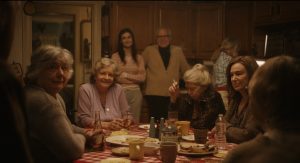 Surrounded by her large extended family, including Aunts Madge (Joyce Van Patten, seated, second from left) and Ina (Phyllis Somerville, seated, second from right), Diane Rhodes (Mary Kay Place, seated, right) finds support for her many endeavors as seen in the insightful new character study, “Diane.” Photo courtesy of IFC Films.[/caption]
Surrounded by her large extended family, including Aunts Madge (Joyce Van Patten, seated, second from left) and Ina (Phyllis Somerville, seated, second from right), Diane Rhodes (Mary Kay Place, seated, right) finds support for her many endeavors as seen in the insightful new character study, “Diane.” Photo courtesy of IFC Films.[/caption]
Nevertheless, despite such sincere, heartfelt support, Diane is relentlessly driven in her pursuit of caring for others. But why? That’s what her story gradually reveals. Much of this compulsion seems to be rooted in making up for past mistakes; by doing good, she hopes that she can atone for the errors of her ways, including, somewhat inexplicably, those for which she has already been forgiven. What’s more, with everyone she loves aging and moving ever closer to death, Diane is faced with the shattering of a cherished but naïve longstanding belief that everyone lives forever. This is a painful truth that she quietly hopes to deny by perpetually keeping busy, an effort that ultimately, inevitably and sadly goes for naught with virtually everyone she seeks to help.
How will Diane resolve these issues for herself? That’s what remains to be seen as her story (and those of everyone else around her) plays out. One can only hope that she comes up with answers that satisfy her sensibilities and provide her with the peace of mind that forever seeks to elude her – before life catches up with her.
On its face, “Diane” may seem like a simple tale about daily living, a study of a fairly ordinary character. Most of us probably know a “Diane” of our own, one who continually gives and gives and asks for little in return. It’s a rather common character type, one rooted in reality and not at all that unusual.
So why should we care about her or her story? It’s because this film takes a very deliberate approach in telling it, specifically when it comes to showing how we shape our existence through our thoughts, beliefs and intents, the building blocks of the conscious creation process, the philosophy that maintains we manifest our reality through these metaphysical tools. And writer-director Kent Jones has done an excellent job in demonstrating that for us, an approach that’s part instruction manual, part cautionary tale and part exercise in enlightenment.
As discussed above, Diane’s reluctance to accept help is clearly rooted in her beliefs about herself. She believes she needs to continually do good works for others to make up for past misdeeds. In some ways, it’s easy to understand how she might feel that way, especially given the often-guilt-ridden way that many of her generation were raised. But must we perpetually devote ourselves to the well-being of others at the expense of ourselves out of some sense of obligation, even in instances where we’ve been forgiven for our transgressions? Well, that depends, but, no matter what, that’s where our beliefs come into play. If that’s what we believe we must do, then that’s how our existence will unfold. But we should understand, as the film attempts to make clear, that this is not an intractable absolute; we have other options open to us if we choose to avail ourselves of them. In the end, though, it all depends on the beliefs we choose to embrace, as they’ll set in motion what results. This is the lesson for Diane – and for those of us who share her outlook.
There’s certainly nothing wrong with wanting to be of help to others. In fact, conscious creation maintains that one of its most laudable objectives is to engage in acts of value fulfillment, the concept that maintains we act as our best, truest selves for the benefit of ourselves and those around us, based on our beliefs. Where Diane is concerned, she certainly has the benefit to others part down, but, when it comes to being of benefit to herself, that’s obviously open to debate.
Conscious creation asserts that we manifest our own reality, not the reality of others (even though they may benefit from our efforts in some ways). If we’re make the most of that, then we must be sure that we create circumstances that allow us to operate from a position of personal strength, not only to take care of ourselves, but also to engage in the good works we choose to do for others. Continually giving ourselves over to the needs of others without taking care of ourselves will eventually take a toll on us, making it difficult or impossible to help ourselves or those we seek to serve. This is, in effect, an act of giving away our personal power, something that won’t end up serving anyone in the long run.
[caption id="attachment_10666" align="aligncenter" width="300"]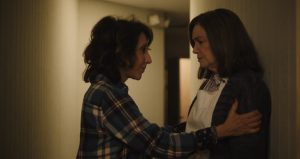 Relentlessly driven Samaritan Diane Rhodes (Mary Kay Place, right) receives encouragement to take care of herself from friend and fellow volunteer, Bobbie (Andrea Martin, left), in writer-director Kent Jones’s debut fictional feature, “Diane.” Photo courtesy of IFC Films.[/caption]
Relentlessly driven Samaritan Diane Rhodes (Mary Kay Place, right) receives encouragement to take care of herself from friend and fellow volunteer, Bobbie (Andrea Martin, left), in writer-director Kent Jones’s debut fictional feature, “Diane.” Photo courtesy of IFC Films.[/caption]
This is an important consideration in learning how to make the most of the time we’ve got. By wisely employing our metaphysical resources, we have an opportunity to maximize our accomplishments, as well as our enjoyment and satisfaction of life. This grows ever more critical the further we travel down the road of life, a notion depicted as a cinematic metaphor throughout the film. It becomes particularly crucial the closer we come to the end; we must ask ourselves, how do we want to spend the time we have left? Where do we want to place our thoughts, beliefs and intents? Do we indeed wish to make the most of things for ourselves and those we seek to help? Or are we going to fritter our time away worried about inconsequentials, such as insignificant details, the opinions of others or ill-placed, self-created feelings of trumped-up guilt? There’s powerful food for thought in this, again both for Diane and those of us who share her perspective.
We must also be mindful about others’ feelings in how we conduct ourselves in these areas. For example, Diane nearly always turns down the assistance others offer her, believing she’s somehow not worthy of it. But does she ever consider that she might be denying others the opportunity to be of service to someone who needs help? One could even go so far as to say that her attitude is a selfish one, because she prevents others from living out their value fulfillment. It’s a consideration we should always keep in mind when such situations arise. We might even learn something from them, namely, that it’s perfectly fine to be the recipient of aid and not always the one to dispense it.
[caption id="attachment_10667" align="aligncenter" width="300"] Seeking solace in the woods of Upstate New York helps provide comfort to overburdened caregiver Diane Rhodes (Mary Kay Place) in the insightful new offering, “Diane.” Photo courtesy of IFC Films.[/caption]
Seeking solace in the woods of Upstate New York helps provide comfort to overburdened caregiver Diane Rhodes (Mary Kay Place) in the insightful new offering, “Diane.” Photo courtesy of IFC Films.[/caption]
As we undergo such experiences, we may discover aspects of ourselves of which we were unaware. This is essential to our personal evolution, a process directly in line with the conscious creation concept that we’re all in a constant state of becoming. This raises the prospect of living a life that is perpetually revelatory, a theme that permeates Diane’s story on multiple levels and becomes more apparent the further it progresses. It also shines a light on the notion that nothing lasts forever, a difficult truth that Diane must come to terms with, especially when it comes to realizing that, in the end, everybody dies, no matter how hard we may work at trying to prevent it from happening.
This may seem like a lot to take in from a simple story about the life of an aging caregiver. But that’s precisely what makes this such a quietly powerful and poetic film. Rich in insight and symbolism, this little drama elevates a seemingly everyday tale to the height of inspired storytelling. We can thank writer-director Jones for giving us such a touching tale. We can also thank executive producer Martin Scorsese for backing this project, the kind of profound, introspective piece one might expect from the onetime aspiring priest-turned-filmmaker. Mary Kay Place gives an excellent performance in an uncharacteristic dramatic role, backed by a superb cast of supporting players, including many veterans who bring their best game to their roles. Please note, though, that this one may not last long in theaters, so catch it while you have the chance – you won’t be disappointed.
It’s been said that “life is what you make of it.” But how often do we really take the time to examine that statement? What exactly are we making of it? And are we even aware that we truly can do so? We may glibly agree to the idea in passing conversation, but are we really employing the notion in our everyday lives (and, if so, to what end)? Thankfully, “Diane” helps to bring these questions into sharp focus, important considerations for those of us who are closer to the finishing line than the starting point. It’s something we should take to heart and seek to work out while we still have the time and opportunity. It would indeed be a shame to let the clock run out with our work unfinished – and our peace of mind still in limbo.
Copyright © 2019, by Brent Marchant. All rights reserved.
Reviews of "The Best of Enemies," "Neurotic Quest for Serenity" and "Amazing Grace" are all in the latest Movies with Meaning post of the web site of The Good Media Network, available by clicking here.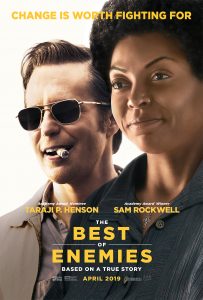



“The Best of Enemies” (2019). Cast: Taraji P. Henson, Sam Rockwell, Babou Ceesay, Nick Searcy, Wes Bentley, Anne Heche, Bruce McGill, John Gallagher Jr., Nicholas Logan, Gilbert Glenn Brown, Caitlin Mehner, Mckenzie Applegate, Nadej Bailey, Kevin Iannucci, Charles A. Black, Dolan Wilson, Tim Ware, Ned Vaughn. Director: Robin Bissell. Screenplay: Robin Bissell. Book: Osha Gray Davidson, The Best of Enemies: Race and Redemption in the New South. Web site. Trailer.
Many of us dislike change, but sometimes it’s positively essential, no matter how much we may dread it. However, if we approach it with an open mind, a willingness to examine why we resist it and a spirit of cooperation to see the process through, making alterations and adjustments need not be as daunting as we believe it to be. Such was the case for a group of seemingly immovable citizens who wrestled with this question in the inspiring new fact-based drama, “The Best of Enemies.”
Even though 1971 might not seem like long ago to those of us of a certain age, it was very much a different time. This was especially true in some parts of the country and among particular constituencies, circumstances clearly reflected through their spokespeople.
Consider activist Ann Atwater (Taraji P. Henson). The feisty, highly passionate, always-outspoken community leader was someone not to be messed with. She never hesitated to make her opinion known, especially when it came to supporting the rights and well-being of her African-American constituents in the highly segregated city of Durham, North Carolina. She fought hard for her peers, sometimes even chastising her kindreds if they weren’t willing to work as hard as she did when it came to seeking justice and fair treatment.
Of course, Atwater wasn’t alone. The same approach she brought to the table could be said of C.P. Ellis (Sam Rockwell), the leader of the local Ku Klux Klan chapter. Ellis never tried to conceal his prejudicial attitudes, doing all he could to further the cause of segregation and promote the aims of White supremacists. Not only did he never hesitate to intimidate members of the Black community; he also took steps to bring his fellow Caucasians “into line” if they openly showed sympathy or support for minorities. He also had ample support for his efforts, such as the quiet backing of influential businesspeople and politicians, such as city councilman Carvie Oldham (Bruce McGill).
[caption id="attachment_10651" align="aligncenter" width="300"]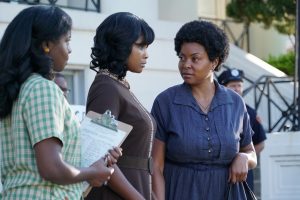 Community activist Ann Atwater (Taraji P. Henson, right) fights hard for her constituents in a segregated community in 1971 in the new fact-based drama, “The Best of Enemies.” Photo by Annette Brown, courtesy of STXfilms.[/caption]
Community activist Ann Atwater (Taraji P. Henson, right) fights hard for her constituents in a segregated community in 1971 in the new fact-based drama, “The Best of Enemies.” Photo by Annette Brown, courtesy of STXfilms.[/caption]
It’s hard to imagine two individuals who were more diametrically opposed to one another. So it’s almost impossible to fathom how they could have been drawn together to work out an issue they had in common.
The trigger for this unlikely collaboration was a fire at a predominantly African-American grade school. When the flames destroyed a substantial portion of the building, the students were displaced and in need of a new educational facility. Atwater and her followers supported a proposal to transfer the affected students to other, predominantly White schools while their structure was being rebuilt. But no sooner was the issue raised when it met with abundant vocal opposition from Ellis and his constituents. And, when the proposals were brought before the city council, they were summarily defeated.
However, when word of the proposal’s defeat reached the NAACP, the organization contacted Atwater, urging the filing of a lawsuit. The case ended up on the docket of Judge Leslie Hallford (Tim Ware), who wanted to do whatever he could to avoid having to try the case. After consulting Wilbur Hobby (Ned Vaughn), counsel to the court, the judge decided to pursue his attorney’s recommendation – calling for the formation of a charrette, an intensive, citizen-based planning session in which community members come together to work out a solution for the problem at hand, one that’s subsequently submitted to officials for review and possible ratification. Hobby then contacted Bill Riddick (Babou Ceesay), a facilitator experienced at organizing such programs, to see if he would be interested in conducting a charrette in Durham, an offer he quickly accepted.
Upon Riddick’s arrival in Durham, he assessed the situation and met with potential key players. The facilitator wanted chairpersons for the charrette who would be most representative of, and most zealous in advocating for, their respective communities. Given that this was a racially divided issue, he believed that meant finding suitable spokespersons for Black and White constituencies, namely, Atwater and Ellis.
Needless to say, the representative candidates were reluctant to even be in one another’s company, let alone work together. However, thanks to Riddick’s eminently convincing persuasiveness, he was able to bring the unlikely duo together to lead the charrette. Thus began a contentious yet transcendent process through which diehard combatants came together to reach resolution, a journey filled with tension, revelation and transformation.
[caption id="attachment_10652" align="aligncenter" width="300"]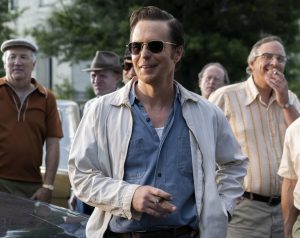 C.P. Ellis (Sam Rockwell, center), leader of the local Ku Klux Klan chapter, does all he can to promote the cause of segregation in Durham, North Carolina in 1971 as seen in the new fact-based drama, “The Best of Enemies.” Photo by Annette Brown, courtesy of STXfilms.[/caption]
C.P. Ellis (Sam Rockwell, center), leader of the local Ku Klux Klan chapter, does all he can to promote the cause of segregation in Durham, North Carolina in 1971 as seen in the new fact-based drama, “The Best of Enemies.” Photo by Annette Brown, courtesy of STXfilms.[/caption]
Confronting the unknown can be a scary prospect, no matter how much we might try to put up a brave front. But, when the apprehension is stripped away, in nearly every case like this, the fear comes from a lack of knowledge, a failure or inability to understand what makes others different from us. This can create a major source of discomfort, one that often is perpetuated and strengthened through our beliefs. And those beliefs, in turn, make that discomfort into a reality, an outcome of the conscious creation process, the philosophy that maintains we draw upon these metaphysical building blocks to construct the existence we experience.
However, once we understand this, it should also be apparent to us that such manifestations are made – and are equally capable of being unmade, transformed into different configurations, including those that seem more familiar and don’t prompt the feelings of anxiety that can become cemented in our consciousness and, subsequently, in the reality before us.
Knowing that, then, we’re never locked into an intractable, unchangeable situation unless we specifically choose to be. Intentionally taking steps to learn about what distresses us can thus open us up to new possibilities, ideas we may have never previously considered due to belief blockages that have kept us from doing so.
This is precisely what happened in the Black and White communities in Durham, especially in the lives of the two protagonists. Ellis came to see that the Black community was made up of human beings, in many ways just like those of his constituency. And Atwater gradually realized that Ellis was not the devil incarnate, that her adversary had traits that made him just as human as those in her community. It took some time for these realizations to fall into place, but, by spending time working together and seeing one another up close, an understanding took root that subsequently changed the beliefs – and reality – that each of Ellis and Atwater experienced.
This exercise in overcoming limitations and breaking down barriers is a primary objective of the conscious creation process. It’s reflective of its principal notion that we’re all in a constant state of becoming. What Riddick, Atwater and Ellis were able to achieve shows how radical change, no matter how outlandish it may initially seem, is indeed entirely possible, as long as we leave ourselves open to the possibility, something that begins with our beliefs.
For this to work, there are a number of other considerations that need to come into play. For instance, personal integrity is crucial, for it taps directly into the genuineness of one’s beliefs. If we’re to attain optimum results with our creations, we must make sure that we’re being scrupulously honest with ourselves when it comes to their underlying cornerstones. This became a critical issue for two White representatives of the charrette’s senate (John Gallagher Jr., Caitlin Mehner), the community members who actually voted on the citizen proposals put before them. They had to run their beliefs through their personal integrity filters when they were intimidated by Klan members and public officials who wanted them to vote down proposals favorable to the Black community. Being true to oneself when it comes to balancing the needs of the public and those of the individual can be challenging, especially when one’s personal safety and well-being are on the line.
[caption id="attachment_10653" align="aligncenter" width="300"]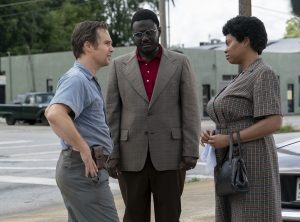 Community activist Ann Atwater (Taraji P. Henson, right) and Ku Klux Klan leader C.P. Ellis (Sam Rockwell, left) are brought together by facilitator Bill Riddick (Babou Ceesay, center) to resolve common issues in the new fact-based historical drama, “The Best of Enemies.” Photo by Annette Brown, courtesy of STXfilms.[/caption]
Community activist Ann Atwater (Taraji P. Henson, right) and Ku Klux Klan leader C.P. Ellis (Sam Rockwell, left) are brought together by facilitator Bill Riddick (Babou Ceesay, center) to resolve common issues in the new fact-based historical drama, “The Best of Enemies.” Photo by Annette Brown, courtesy of STXfilms.[/caption]
This is another instance where the importance of overcoming those aforementioned fears is paramount. If we allow our fear-based beliefs to hold sway, we’ll never make any progress, for they undercut any efforts we initiate to make change. Admittedly, this may be difficult, but it’s essential to avoid stagnation.
It’s interesting to note how the process of change can take on a life of its own once it starts to be implemented. For example, in this case, this began with finding a school for the students displaced by the fire. But, once the charrette participants started examining the students’ circumstances, they found there were more problems than finding a new place for them to attend classes. They discovered that the students in the Black school were lagging behind their White counterparts due to such problems as using outdated textbooks and following inadequate curricula. Once revealed, these issues became fodder for other shortcomings to be addressed and corrected through the charrette’s deliberations.
This thus raises an intriguing question about why the fire may have happened: Was it simply due to some unforeseen combustible issue? Or was it a catalyst to start the ball rolling where these issues were concerned? After all, would they have come up for discussion were it not for the fire that helped reveal and raise these matters in the first place? Indeed, had the fire not occurred, these problems may have persisted much longer without resolution.
Scenarios such as this often tend to extend to issues that go beyond simply what’s most at hand. They encourage us to dig deeper, to take more probing looks at what we’re creating and why, including the manifesting beliefs that underlie whatever results. This can be quite revelatory and transformative, leading to all manner of previously unconceived possibilities, such as the fact that, as unlikely as it may seem, Atwater and Ellis became life-long friends in the wake of their charrette experience. Now that’s change.
Despite a general tendency toward following formula and overstaying its welcome, this tale about an unlikely alliance that arises from worlds apart partners shares messages that we can’t seem to get enough of these days. The fine performances of Henson and Rockwell give life to a story that starts out small and swells to larger issues that we can all benefit from learning about. This is due in part to the picture’s refreshingly balanced screenplay, which doesn’t hesitate to show the negative side of a likable character and the positive side of one generally seen as despicable. Only by getting a closer look at such questions will we be able to get past the prejudices and their associated beliefs that hold us back.
A word of note is in order here with regard to what many critics have been saying about this film. Many have called it simplistic in its approach, condescendingly writing that it covers trite, stale territory that’s been examined many times before and that we should all know by now. In doing so, many have unfairly bashed this offering in much the same way they did recent Oscar winner “Green Book” (2018). But, quite frankly, I find such patronizing responses appalling.
As indicated above, there are aspects of this film that could have been handled better. On balance, though, this picture, like “Green Book,” is competently made and makes its case sincerely without becoming schmaltzy, simplistic or dogmatic. Those who have said otherwise are certainly entitled to their opinion, but, when their comments are as unduly smug, cynical and snide as many of them have been, I have to wonder whether they’re trying to present legitimate film criticism or to show off how smarmy and supposedly sophisticated they and their writing are.
Meaningful change can indeed be hard to come by. It takes work, both in our actions and in the underlying beliefs that give rise to them. In an age where we’re still being tested on these fronts, we must remain mindful of the challenges that are still at hand, including those that many of us (erroneously) believe have disappeared. Fortunately, we have examples like those illustrated in this film to help show us the way. Those who think we can’t learn anything from the past are sorely mistaken, for, if it was possible to institute reform at a time when circumstances were considerably more difficult than they are today, then what excuse do we have now?
Copyright © 2019, by Brent Marchant. All rights reserved.
Tune in for the latest Cinema Scribe segment on Bring Me 2 Life Radio, today, April 16, at 2 pm ET, available by clicking here. And, if you don't hear it live, catch it later on demand!

“Neurotic Quest for Serenity” (“Transfornada Obsessiva Compulsiva”) (2018). Cast: Tatá Werneck, Vera Holtz, Bruno Gagliasso, Luis Lobianco, Daniel Furlan, Pedro Wagner, Mário Gomes, Patricya Travassos, Ingríd Guimarães, Luciana Paes. Directors: Paulinho Caruso and Teodoro Poppovic. Screenplay: Paulinho Caruso and Teodoro Poppovic, with Pedro Aguilera, Tatá Werneck, Mauricio Bouzon and Tainá Muhringer. Source Collaborators: Daniel Duncan, Gustavo Suzuki and Hell Ravani. Web site. Trailer.
Peace of mind can be elusive, especially when we feel overwhelmed by everything happening around us – or to us. As the pressure mounts, we may begin to feel ourselves fraying at the edges as the stress creeps deeper and deeper into our being. And we can only tolerate these circumstances for so long before they finally take a toll on us, leading to anxiety or weariness and possibly even a meltdown. So it is for an overburdened actress seeking to keep it all together in the manic Brazilian farce, “Neurotic Quest for Serenity” (“Transfornada Obsessiva Compulsiva”), now available on video on demand.
Kika K (Tatá Werneck) feels like she’s coming apart at the seams. The popular Brazilian telenovela star tries to manage a full plate of commitments, a challenge made difficult by her hyper-aggressive agent, Carol (Vera Holtz), who constantly books her client for acting and publicity gigs, sometimes without informing her until the last minute. But, if that weren’t bad enough, Kika also suffers from OCD, as well as an overactive imagination and vivid dreams, all of which have started sneaking their way into her perceptions of everyday reality.
Kika realizes she must get a handle on her life, but she has no idea how. It’s a frustrating conundrum made comically ironic by Carol’s surprise announcement that she’s arranged for her client to participate in a promotional tour for a self-help book that bears her name, a title of which Kika was completely unaware, penned by an enigmatic ghost writer (Pedro Wagner). In addition to all her other responsibilities, Kika must now prepare for book signings and media appearances, such as a guest spot on a TV talk show featuring popular celebrity host Ana Juliana (Luciana Paes), to plug a book about which she knows virtually nothing despite the presence of her name on the cover.
To complicate matters, Kika must also contend with other challenges, such as the constant advances of her oversexed co-star, Caio Astro (Bruno Gagliasso), the incessant stalking of an obsessed, portly fan, Felipão (Luis Lobianco), and the conniving sniping and machinations of a rival actress, Ingrid (Ingrid Guimarães). Considering all this, it’s a wonder she’s been able to hold things together as well as she has for as long as she has.
Things reach a tipping point, however, when Kika loses it at a book signing. Fortunately, a milquetoast-esque bookstore employee, Vladimir (Daniel Furlan), comes to her rescue, a kindly gesture that she’s not especially appreciative of at first. But, once she starts coming to her senses, Kika realizes she’s found an unlikely knight in shining armor, one who sets her on the path of sorting out her life. Of course, given all the challenges she’s been facing, the road to serenity going forward continues to be riddled with potholes that make her journey an odyssey full of adventure and lunacy.
[caption id="attachment_10642" align="aligncenter" width="300"] Telenovela star Kika K (Tatá Werneck, left) seeks solace from the craziness in her life with introverted bookstore employee Vladimir (Daniel Furlan, right) in the Brazilian screwball comedy, “Neurotic Quest for Serenity” (“Transfornada Obsessiva Compulsiva”).[/caption]
Telenovela star Kika K (Tatá Werneck, left) seeks solace from the craziness in her life with introverted bookstore employee Vladimir (Daniel Furlan, right) in the Brazilian screwball comedy, “Neurotic Quest for Serenity” (“Transfornada Obsessiva Compulsiva”).[/caption]
Will Kika achieve the tranquility she seeks? That remains to be seen. But, if it’s to happen, she needs to make some changes to reshape her reality, all of which start with her.
So how did Kika’s life become so topsy-turvy in the first place? Strange as it may sound to some, she brought it upon herself through the conscious creation process, the philosophy that maintains we manifest the reality we experience through the power of our thoughts, beliefs and intents. But, one might ask, why would anyone purposely create an existence like the one Kika experiences?
As I’ve written in the past, why we create what we create is up to each of us; our reasons are our own, and they’re really nobody’s business to question. We can speculate about what’s involved, though, in most cases, our experiences are generally related to learning specific life lessons, and Kika is no exception.
When the foregoing is taken into consideration, it’s apparent that much of what Kika is going through is related to the management of her personal power. In creating the career she’s built for herself, she’s obviously been quite successful in manifesting her professional accomplishments. She’s given herself the attributes needed to attain that, such as acting talent and physical beauty, and those qualities have placed her in great demand (witness the advances of her co-star and her stalker, the many producers eager to hire her, and the jealous glaring of her rival).
Based on this, Kika has apparently done quite an effective job at managing her power-related beliefs. But what accounts for the rest of her life? She’s so put upon by the other influences in her life that she’s overcome by them and in danger of sinking fast. This comes from giving away one’s power, a commodity that Kika desperately needs to retrieve if she doesn’t want to be consumed by these vampiric elements in her life.
Of course, Kika won’t know what it’s like to get her power back unless she creates the opportunity to engage in such an experience (hence the mayhem that surrounds her). She also benefits from the assistance she receives from having a grounding influence in her life, something that accounts for Vladimir’s presence. Even though he has challenges of his own to contend with, he helps Kika get her groove back.
In retrieving our personal power, a key component of this process is deciding on, and then affirming, what we want for ourselves. That might sound simple enough, but it must become rooted in our thoughts, beliefs and intents. Merely relegating it to a passing notion, unfortunately, places it in the realm of wishful thinking, a weaker and largely uncommitted expression of this idea, one that’s unlikely to become grounded and subsequently materialize.
This is an area in which Kika needs to do some work, particularly where her beliefs are concerned. Part of the reason why she lacks the serenity she seeks is that she’s personally unsettled about what she really wants. This would account for her overactive imagination, vivid dreams and OCD, all of which reflect her scattered mindset and rampant indecisiveness, as well as her inability to settle on what she most wants to pursue. Whittling down her options and eliminating the possibilities she sees as unrealistic are essential, but certainty in this regard is unlikely unless she’s willing to make an earnest effort.
This insanely hilarious search for the meaning of life plays like a cross between “Hector and the Search for Happiness” (2014) and “Welcome to Me” (2014). This screwball comedy moves along at a break-neck pace from the outset and never lets up with its outrageous, off-the-wall humor and bizarre, colorful visuals. This directorial feature film debut from Paulinho Caruso and Teodoro Poppovic won’t appeal to everyone, but, for those who like their comedies with an edge, this one is definitely for you. What a wild ride it is!
Life can be funny, but sometimes it’s no laughing matter. Finding the right balance between the two makes for a happy (and fun-filled) medium. That’s perhaps one way of looking at each of our personal quests for serenity. But let’s hope the search includes beliefs that are amendable and manageable – and by no means neurotic.
Copyright © 2018-19, by Brent Marchant. All rights reserved.
“Little Gandhi” (2016). Cast: Interview Footage: Robert Ford, Najlaa Alsheikh, Osama Abu Zayd, Motaz Morad, Ghiath Shurbaji, Muhammad Shihadeh, Shafeek Abdulaziz, Muhanad Abu Alzen, Rana, Hassan Abo-Kinan, Mohammed Namous, Radwan Ziadeh, Ahmad Shurbaji. Archive Footage: John Kerry, David Cameron, Ghiath Matar, Yahya Shurbaji. Director: Sam Kadi. Screenplay: Sam Kadi. Web site. Trailer.
It’s been said that one catches more flies with honey than with dung. While that may be true in many circumstances, it can be a tricky practice in political circles. If nothing else, though, it can make a statement, regardless of whether its objectives are met. So it was with an unconventional but fearless nonviolent activist fighting for change in his beleaguered homeland, the subject of the compelling new documentary DVD release, “Little Gandhi.”
Peaceful protest has often inspired activists to seek change in political regimes in dire need of it. In 2011, with the Arab Spring movement sweeping across the Middle East from Tunisia to Libya to Egypt, the initiative soon made its way to Syria, home of the Bashar al-Asaad regime, one of the world’s most brutal dictatorships. Continuing horrific practices initiated by his father as far back as the 1980s, Asaad ruled with unquestioned authority, relentlessly doling out punishment without regard for the welfare of the nation’s citizens. Such atrocities, combined with a corruption-riddled administration, signaled that this was a situation long ripe for change.
Under conditions like this, there was a natural tendency among many activists to want to lash out in anger. But one of those who stepped to the fore to encourage a different path was Ghiath Matar. Rather than combating the Syrian government forces ordered to put down opposition, Matar suggested a different path – making their voices heard but treating the troops with kindness and courtesy, offering them flowers and bottled water as gestures of goodwill.
Why such an unconventional strategy? Matar believed that distributing flowers and water would defuse the situation before it escalated out of control. According to his colleagues, Matar saw flowers as a symbol of life, something he wanted to affirm through his protests and convey to his opponents. He was convinced that such gestures of peace would help undermine the plans of those ready to engage in violence. To Matar, giving flowers and water to the security forces was a way of showing them that the protestors did not believe the troops were the enemy, that they were all Syrian brothers and that (one would hope) brothers would not fire on brothers.
When protests in Matar’s home town of Daraya began in March 2011, the activists followed through on their plan. The flowers were seen as kind offerings, and the bottled water was much appreciated among soldiers on duty in the desert heat. These gestures and the troops’ responses took authorities by surprise, so much so that they scrambled to come up with a strategy to regain control over their forces. They even went so far as to try and convince the soldiers that the activists had poisoned the water, a ruse that fell apart when the protestors opened the bottles and began drinking from them. Matar’s plan proved successful, revealing him to be someone wise far beyond his 26 years.
Matar’s initiatives were not without precedent. Nonviolent protest was a standard practice in the 1960s American civil rights movement led by Dr. Martin Luther King Jr. and his followers. And the distribution of flowers was a favorite placating tactic employed by Vietnam Era protestors, who frequently dispensed blooms to National Guard troops called upon to keep the peace at antiwar rallies. But measures such as these were perhaps most readily associated with Indian peacemaker Mohandas Gandhi, who made use of them in helping his nation earn independence from the British Empire in the 1940s. In fact, it was his legendary efforts that inspired the nickname attributed to Matar, Little Gandhi.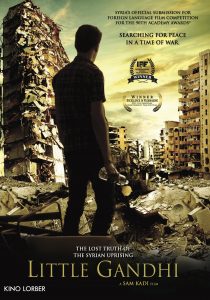
With the assistance of such fellow protestors as Najlaa Alsheikh, Osama Abu Zayd, Motaz Morad, Ghiath Shurbaji, Muhammad Shihadeh, Shafeek Abdulaziz, Muhanad Abu Alzen, Rana, Mohammed Namous and Hassan Abo-Kinan, Matar quickly developed a formidable peaceful opposition network. His hope was that its efforts would raise awareness for the cause, one aimed at ousting Asaad without the nation erupting in what he believed could be a bloody civil war. He and his followers were treading on shaky ground, but they persisted in their efforts nevertheless. They were convinced that now was the time for a regime change; they believed they had the momentum on their side as the Arab Spring movement made considerable headway throughout the region, leading to such huge accomplishments as the toppling of long-time Egyptian president Hosni Mubarek, a leader whose corrupt administration had held power for decades.
Matar’s efforts didn’t go unnoticed by authorities, however. He was constantly threatened by officials, forcing him to stay mobile, often having to seek refuge in farmland hideouts in the areas surrounding Daraya. This wasn’t easy for a newlywed husband and father-to-be, but he did what it took to stay out of sight while planning his next protest. However, when Matar and fellow protestor Yahya Shurbaji were arrested, circumstances took a drastic turn.
Not long after his capture, Matar was tortured and killed. International outrage erupted when word of his death spread far and wide. Foreign leaders condemned this horrendous act, with the ambassadors of many Western nations, including U.S. Ambassador Robert Ford, defiantly attending his funeral.
Unfortunately, with Matar’s death, what he feared the most came to pass – a protracted and bloody civil war, one that left his home town in shambles. In fact, as the film sadly shows, the fighting continued years after the conflict began. This becomes apparent during war zone interviews with activists Motaz Morad and Muhammed Shihadeh, whose comments are frequently interrupted by the sound of gunfire in the background.
What’s more, nearly all of the activists interviewed in the film have been forced to flee Syria. Even though they still actively support the pro-democracy movement, most now live in exile, primarily in Turkey. They are among the approximately 5 million refugees who have fled their homeland in search of safe haven outside their nation’s boundaries.
As for Matar, an organized effort to destroy all records of his efforts – and even of his existence – has been implemented by Syrian officials to squelch any inspiration his memory might evoke. Even photographs of the activist are hard to come by these days. But, despite this purging and Matar’s tragic death, the ideas he inspired can’t be killed. The spirit of Little Gandhi lives on.
Bringing about the kinds of changes that Syrian activists have sought is quite an undertaking. It requires considerable effort, not only for the activities in which they engage, but also in the ideas they devise to make those reforms a reality. They must sincerely believe in what they seek to accomplish, materializing their dreams through the conscious creation process, the philosophy that maintains we manifest the existence we experience through the power of our thoughts, beliefs and intents.
For Matar and his followers, their belief in seeking change is firmly rooted in the faith of their convictions. They knew that reform had to come. For instance, the relentless surveillance of everyday citizens was so pervasive (and intolerable) that most Syrians had come to believe, as activist Mohammed Namous put it, “The walls have ears.” The need for reform had become so plainly apparent that some protestors, like Ghiath Shurbaji, said, without hesitation, “We must change our reality.” Spoken like a true conscious creator.
Many of the activists began cutting their teeth on this subject in 2003, when they made their initial forays into invoking reform. This preliminary exploration helped prime their enthusiasm for what would follow years later, laying a foundation for the grander plans that were to come. It also helped to promote a spirit of cooperation, the kind of unity needed to make acts of co-creation work.
On top of that, though, the initiative required thinking outside the box, overcoming the limitations of conventional thought that might otherwise hold them back or thwart their efforts. This is where Matar’s nonviolent protest strategy came into play. His plan to engage in gestures of kindness and courtesy rather than aggression and hostility kept the rallies from turning violent and derailing the groundswell of support that the campaign was building.
Admittedly, Matar and his colleagues were taking a big chance in implementing their plan. Considering the brutality of the Asaad regime, they could have been made to vanish in an instant. But change seldom results from playing it safe, and Matar’s example lit a fire amongst his peers. He inspired confidence and courage among the activists, helping them to allay the fears that might have otherwise stopped them in their tracks – and keeping the campaign from ever getting off the ground.
Given what happened to Matar, some might question the wisdom of his efforts. However, where would we be as individuals or as a species if we didn’t take chances, following the impulses of our beliefs to see where they lead us? Perhaps visionaries like Matar are the seed planters, invoking ideas that they don’t fulfill personally but who build the platforms on which their ultimate manifestations are constructed. They become the legends who inspire generations of followers who see through on his vision, a testament to his dream and a tribute to the man who birthed the notion into being. And there’s certainly something to be said for that.
This stirring profile of an enlightened visionary leaves quite an impression on the viewer. As Syria’s first-ever entry in the Academy Awards’ best foreign language film category, “Little Gandhi” presents a gripping collection of archive footage from the protests and the civil war, as well as enlightening interviews from activists, authorities and experts, most of whom witnessed the events firsthand. Director Sam Kadi has put together a fine tribute to its heroic subject, one that is sure to motivate those seeking to bring about change where it’s needed, no matter how daunting the conditions might be.
The planet could use more individuals like Ghiath Matar, especially now, and not just in Syria. Let us hope there are impressionable initiates out there who are willing to follow in his footsteps to bring all of us what we crave – and deserve. Indeed, the time has come for all of the other Little Gandhis of the world to step forward and take their rightful place in destiny.
Copyright © 2019, by Brent Marchant. All rights reserved.